Memories Generate Sales, Not Clicks: Why Creating Future Demand Is The Key To Revenue And Profit Growth
Click here to view a 15-minute video of the key findings.
Click here to view or download the Converting Existing Demand and Creating Future Demand deck.
How does advertising work? Jon Lombardo, Global Head of Research at LinkedIn’s B2B Institute, reports, “One of the primary things people misunderstand is how advertising works. People think they just put an ad in front of you and you immediately buy. That’s not how it works. Generally, you don’t generate any sale from an ad, what you do is generate a memory and then at some point later they consult their memory.”
What are the two most important jobs of an advertiser?
A new book and a major study answer these questions and offer key strategies.
James Hurman is a globally recognized expert on brand building and marketing effectiveness, having spent much of his career researching, publishing, practicing, and teaching marketing effectiveness. Hurman has published the Kindle book, Future Demand: Why Building Your Brand Among Tomorrow’s Customers is the Key to Start-Up Success. You can order your copy here.
Hurman and the World Advertising Research Center have also partnered on a major study, Rethinking Brand for the Rise of Digital Commerce. WARC is the major global organization that devotes itself to the study of marketing effectiveness.
The two most important jobs of an advertiser: Converting existing demand and creating future demand
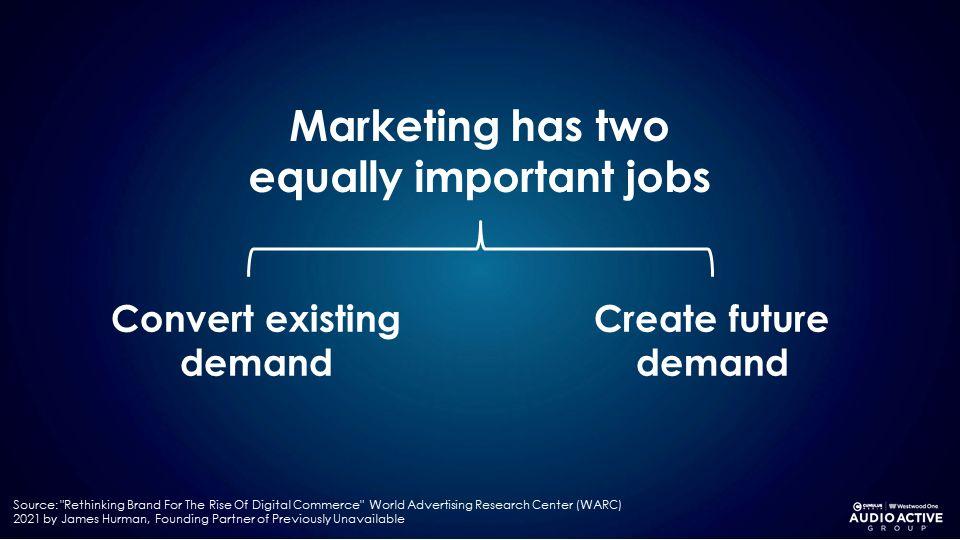
Hurman and the WARC explain:
Converting existing demand is like picking a small number of ripe apples
Imagine an apple orchard that represents all potential customers over the next five years. Converting existing demand is akin to picking apples from the small number of ripe trees. The ripe apples represent the small group of consumers that are “in the market” and ready to buy.
Converting existing demand is advertising to that relatively small group of consumers who are ready to buy and capturing as large a share as possible of them for a product. It is estimated only 1-5% of people are “in the market” at any one period of time. John Dawes of the Ehrenberg-Bass Institute of Marketing Science estimates 5%. Podcast attribution reveals only 1% convert.
Creating future demand is akin to planting apples trees and waiting six to nine months for the new trees to bear fruit
Hurman explains that creating future demand is advertising to that much larger group of consumers who are not in the market and are not ready to buy now but will be in the future. The goal is making them feel familiar with and positively toward an advertiser in order to get them to gravitate toward them when they enter the category.
Creating future demand is planting new apple trees. It takes time and patience for new trees to bear fruit.
Converting existing demand and creating future demand require different creative/copy approaches and different media strategies
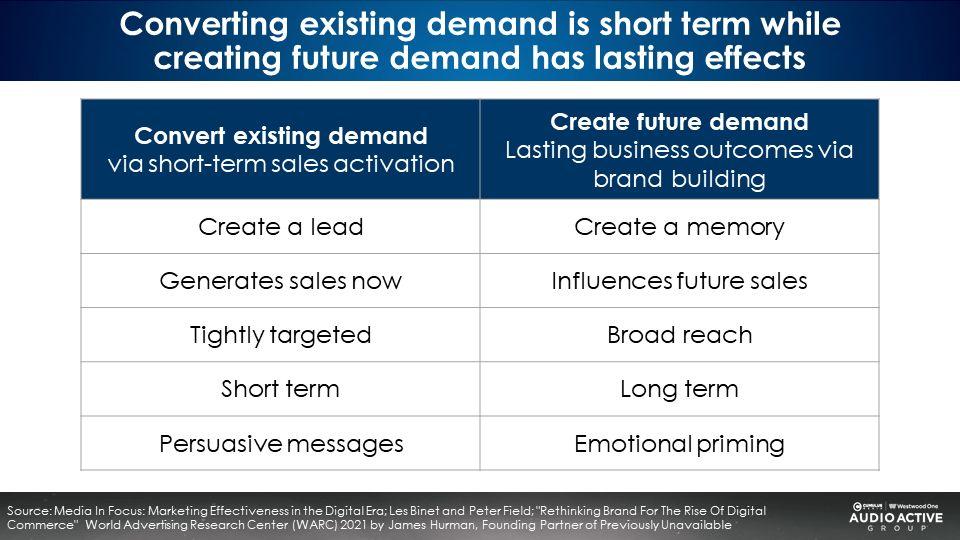
Sales event or promotional copy does not work on the large group of consumers who are not in the market and not ready to buy now. Creating future demand is about creating positive memories.
Converting existing demand has short-term impact but little long-term benefit
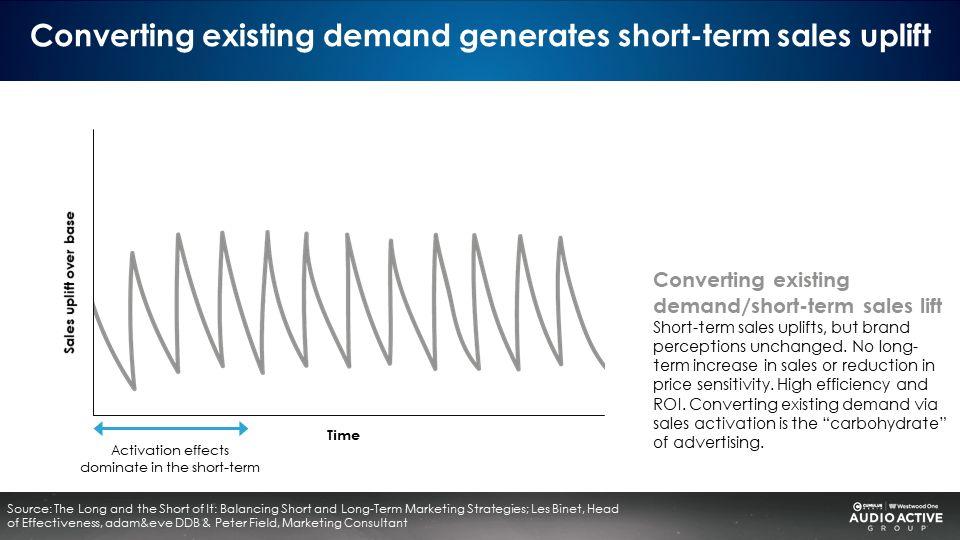
Sales events and promotions are the carbohydrates of advertising
Les Binet and Peter Field, the “godfathers of marketing effectiveness,” describe the sales effect of promotional strategies converting existing demand. Sales event advertising creates sharp short-term sales uplifts followed by quick drop offs. Promotional sales events generate sales “sugar highs” followed by quick crashes.
Creating future demand creates sustained long-term sales and profit growth
The grey line below represents the sales effect of converting existing demand. The blue line represents the sales effect of creating future demand with brand building advertising.
Binet and Field recommend marketers allocate 40% of their marketing budgets to converting existing demand via sales events. They recommend 60% of marketing budgets be devoted to creating future demand via brand building advertising.
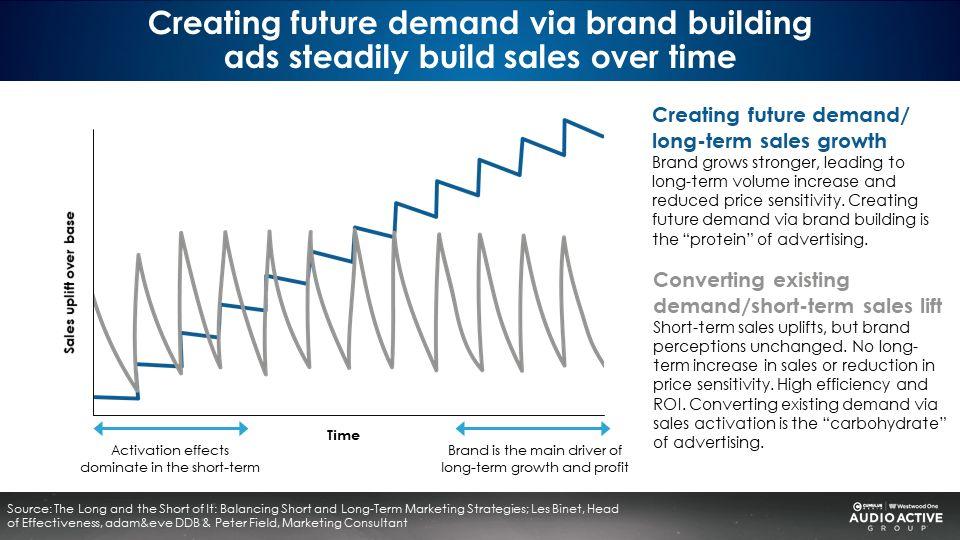
Creating future demand is the protein of advertising
As a business becomes better known, its brand grows stronger, leading to long-term volume increases and reduced price sensitivity. Creating future demand via brand building is the “protein” of advertising.
Performance marketing “valley of death”: When converting existing demand dries up
Sales can plateau when demand hits a wall. Simply put, the sales event machine stops working when the supply of in-market consumers aware of a brand has been exhausted.
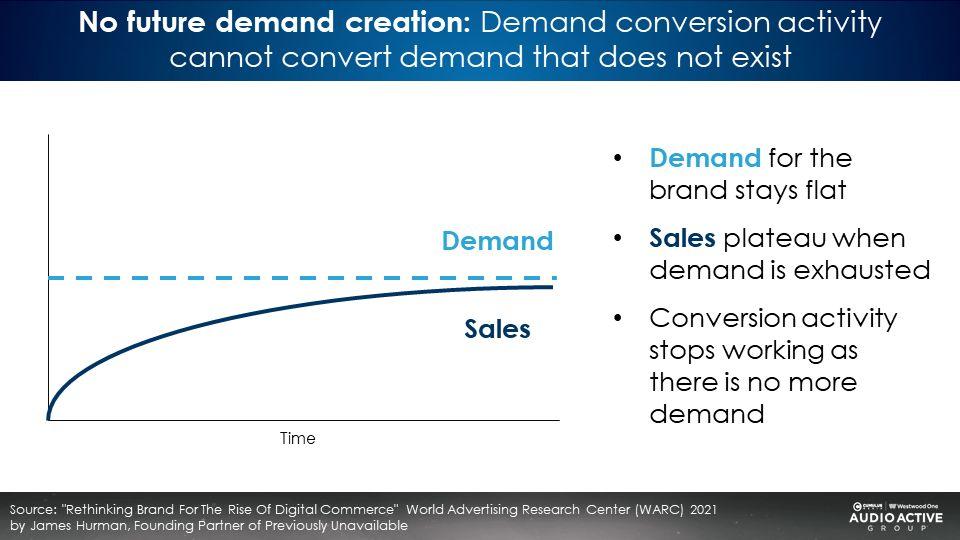
Auto intenders: Only 3% are in-market for a new vehicle; Sales event ads only work on the small group who are ready to buy
The Ehrenberg-Bass Institute of Marketing Science reports only 5% of consumers are in the market for a product or service at any point in time. This holds true for business-to-business and consumer categories.
In the case of local auto dealers, new vehicle sales data reveals only 3% will purchase a vehicle during a three-month period. So the “hurry, hurry, buy now” advertising strategy only works on the 3%. For those not in the market, sales event ads are ignored or seen as irritating.
Auto future demand: 24% will purchase a vehicle over the next two years
There is a much larger group of people who are not ready to buy now but will be ready within a few years. In the case of automotive, 24% could be in the market over the next two years. Auto future demand is eight times bigger than existing demand (24% future demand versus 3% in-market demand).
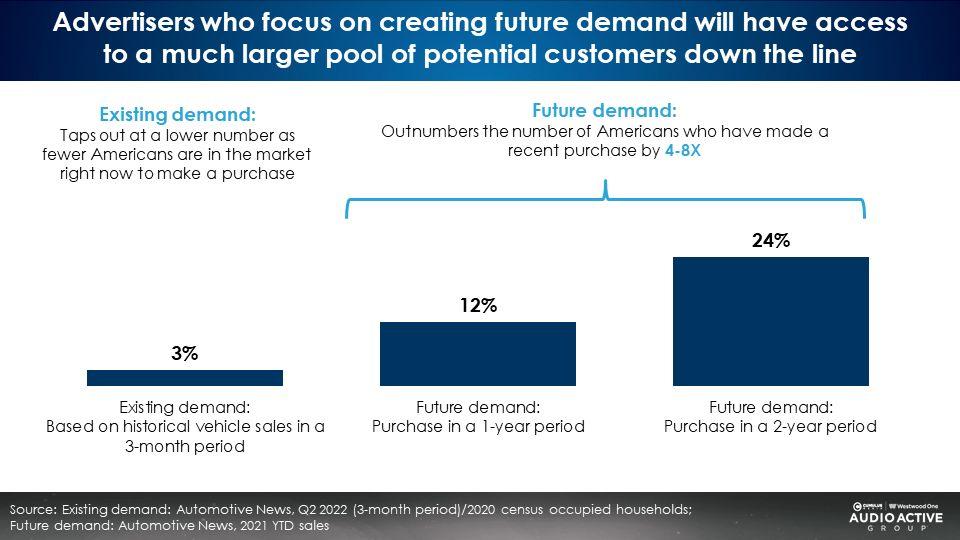
What happens when businesses driven by sales events begin to create future demand? At first, nothing
The way to escape the performance marketing “valley of death” is to begin creating future demand. Be patient. You cannot expect to immediately pick apples from trees you just planted!
According to Hurman and WARC, when a business primarily driven by sales events begins brand building advertising to create future demand, there is a period when flat sales persist while future demand is being created. It takes time for future demand to build over time. Eventually, sales pick up when sufficient future demand has been created.
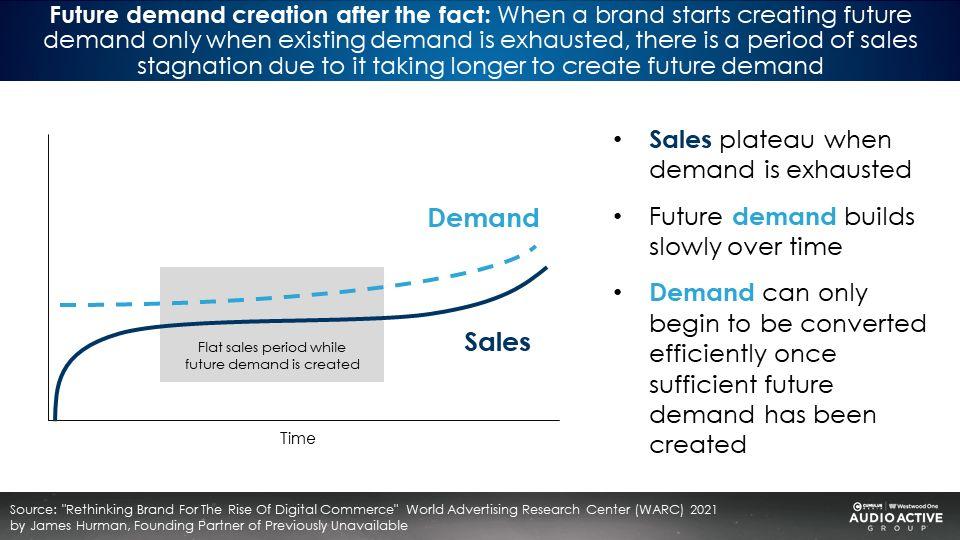
When a business stops creating future demand advertising: At first, there’s a false sense of security as sales maintain; Then the bottom drops out
When a firm reduces brand building and stops creating future demand, at first sales do not drop. Then sales decay.
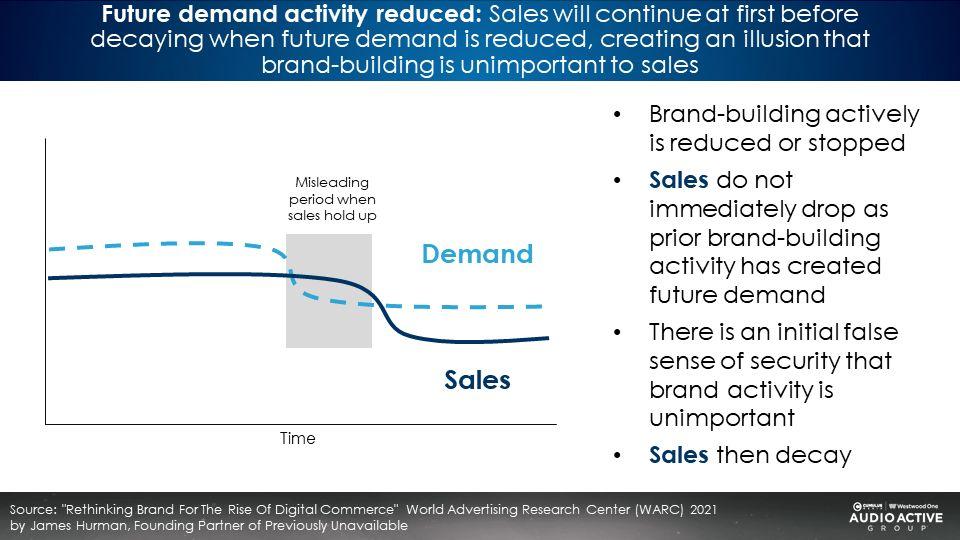
Firing on all cylinders: When a business consistently uses brand building to create future demand and sales events to convert existing demand, great things happen
According to Hurman and WARC, when future demand is created consistently, sales growth can be maintained. Successful businesses constantly plant new apple trees while picking ripe apples from orchards that have grown over time.
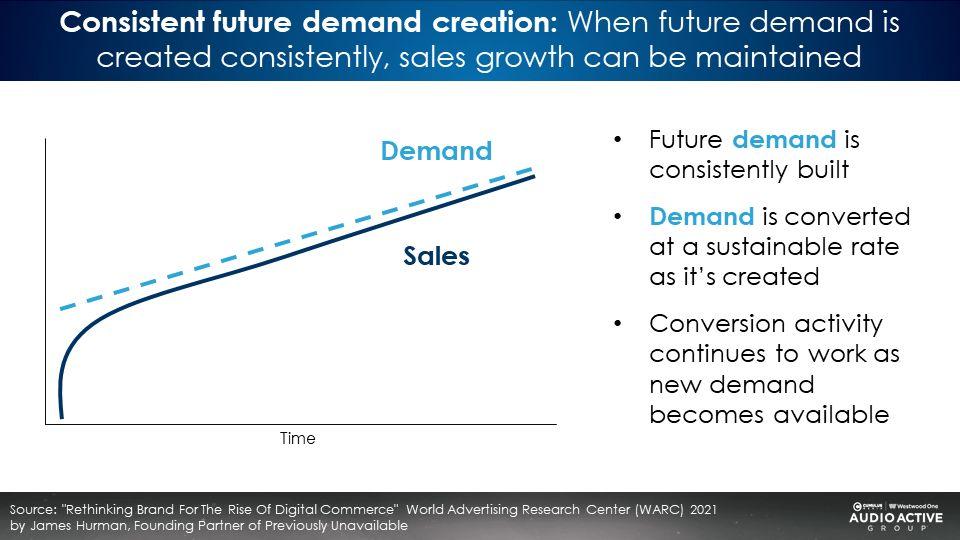
Creating future demand by building positive memories creates strong brands: Companies with strong brands sell more at every price point
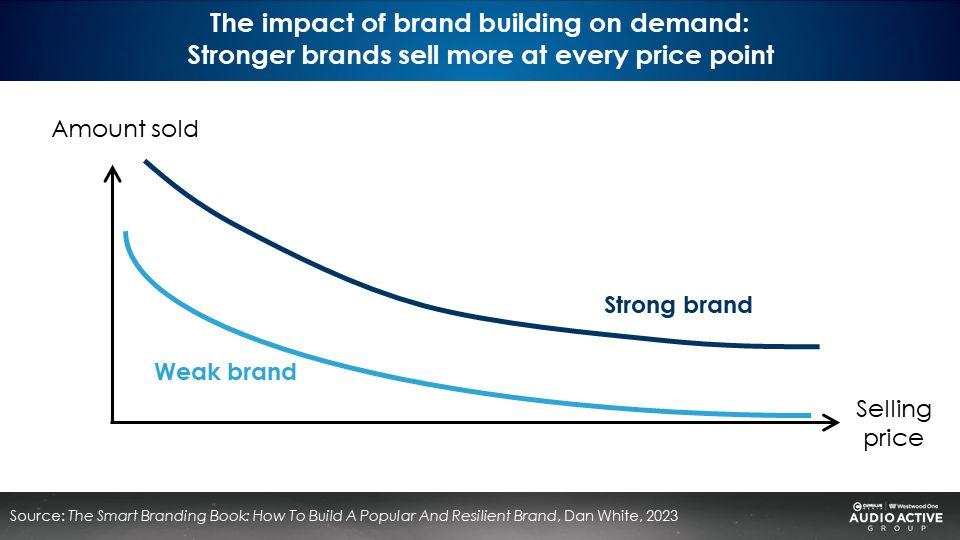
Dan White’s wonderful pocket-sized book, The Smart Branding Book: How to Build a Popular and Resilient Brand, reveals the impact of brand building on the demand curve. As price increases, the volume sold drops.
However, businesses with a strong brand are able to sell more than firms with a weak brand. At every price point, the strong brand is able to drive more sales.
Strong brands drive much more sales volume at better prices
White cites Kantar Millward Brown research that reveals strong brands have 5X the sales volume of weak brands. Most significantly, strong brands can achieve 10% greater price premiums than weak brands.
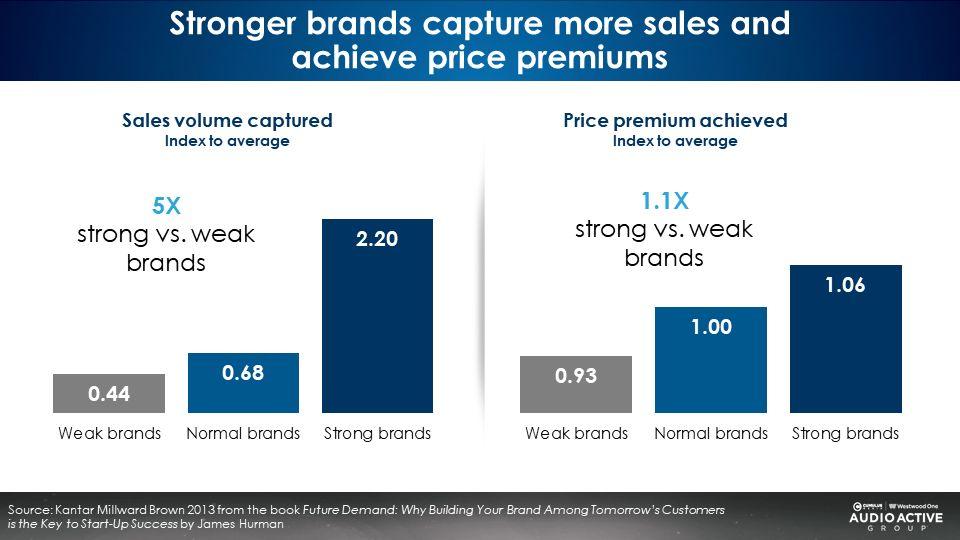
Measuring impact of converting existing demand and creating future demand
The measurement of the impact of short-term converting existing demand campaigns is all about short-term metrics: clicks, conversions, purchase, and cost per acquisition. The measurement of creation of future demand is focused on measuring brand equity: awareness, consideration, and preference.
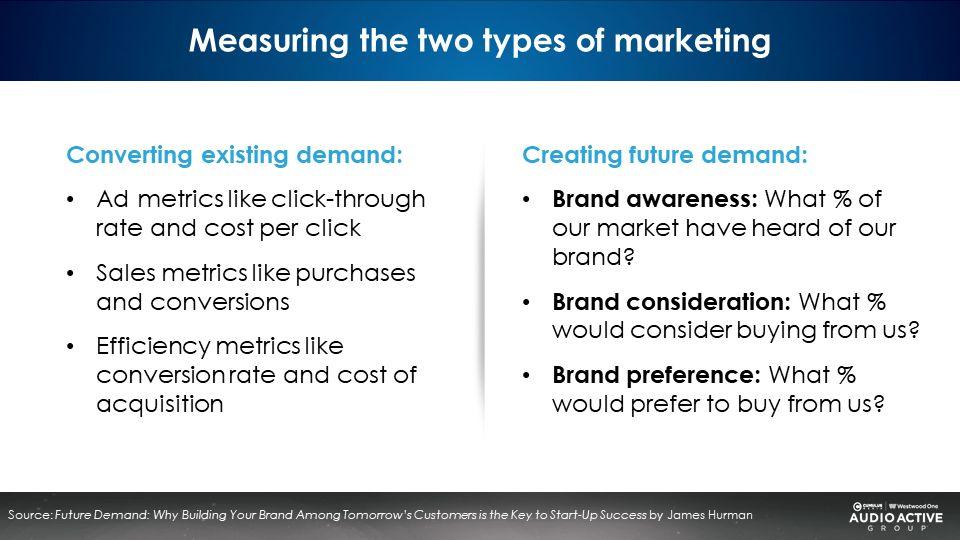
What is the effect of marketing investments over time? The “18-24-58” rule
Marketing media mix modeling firm Gain Theory published a major study entitled, Profit Ability: The Business Case for Advertising. Using the visual analogy of the iceberg, they report:
- Only 18% of marketing investment impacts the short-term month.
- 24% of advertising sales effect occurs from month two to month five.
- The vast majority of advertising impact (58%) occurs six months and beyond. That is the massive portion that is “below the waterline” and represents advertising’s largest sales effect.
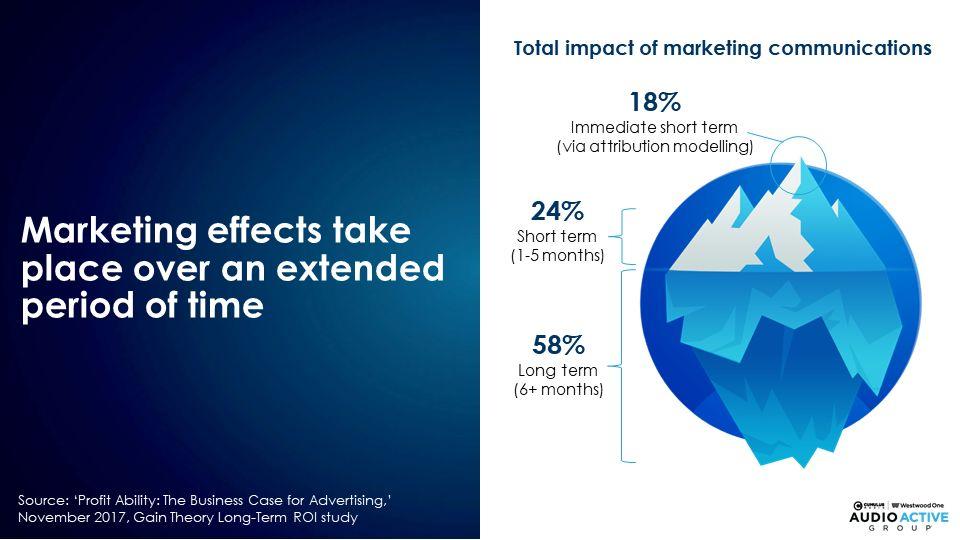
Recall that only a tiny percentage of consumers (1% to 5%) are in the market for a product or service in the short term. A much larger group of consumers will come into the market in the longer term. No wonder the long-term (six+ months) sales effect of advertising is three times (58% versus 18%) that of the current month.
Gain Theory observes, “Across the brands analyzed in this study, online attribution only measured 18% of the total impact of marketing on sales. If business were to optimize their advertising investment based on this (short term impact), then the result would be cutting budgets and hugely undervaluing the total profitability driven by advertising.”
Creating future demand creates memories and memories generate sales; Clicks don’t generate sales
He continues, “This is in some sense the double benefit of brand. It’s more likely to come to mind and even if you do click, you’re still going to click on the strongest brand. It explains what’s really important in marketing is not bottom of funnel, lead generation clicks. It’s top of funnel, brand building memory. That’s the fundamental idea.”
Key takeaways:
- The two most important jobs of an advertiser: Converting existing demand and creating future demand
- Converting existing demand is like picking a small number of ripe apples
- Creating future demand is akin to planting apples trees and waiting six to nine months for the new trees to bear fruit
- Converting existing demand and creating future demand require different creative/copy approaches and different media strategies
- Converting existing demand has short-term impact but little long-term benefit
- Creating future demand creates sustained long-term sales and profit growth
- Auto intenders: Only 3% are in-market for a new vehicle; Sales event ads only work on the small group who are ready to buy
- When a business stops creating future demand advertising: At first, there’s a false sense of security as sales maintain; Then the bottom drops out
- Firing on all cylinders: When a business consistently uses brand building to create future demand and sales events to convert existing demand, great things happen
- Creating future demand by building positive memories creates strong brands: Companies with strong brands sell more at every price point
- Strong brands drive much more sales volume at better prices
- Creating future demand creates memories and memories generate sales; Clicks don’t generate sales
Download the deck:
Click here to view a 15-minute video of the key findings.
Pierre Bouvard is Chief Insights Officer of the Cumulus Media | Westwood One Audio Active Group®.
Contact the Insights team at CorpMarketing@westwoodone.com.